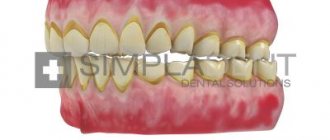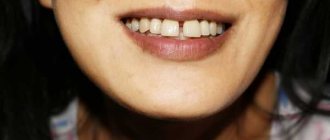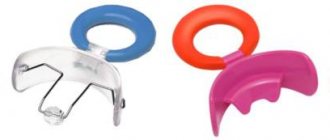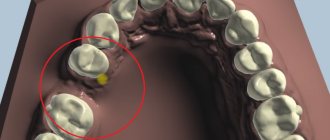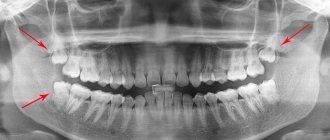What does “impacted tooth” mean, when does such a pathology occur and how to correct it
Multi-rooted molars and especially wisdom teeth are more susceptible to such pathological phenomena as retention and dystopia. In such cases, the crown erupts only partially or remains under the gum, and then the tooth is called impacted. If it is strongly curved and grows in the wrong direction, a diagnosis of dystopia is made. Such figure eights can create favorable conditions for the development of caries and inflammatory processes in the mucous membrane, putting pressure on neighboring elements in a row, leading to their gradual displacement and destruction. Therefore, impacted and dystopic teeth most often need to be removed. Read further in this article about what these pathologies are, how they can be dangerous and whether the problematic element needs to be removed.
Retention and dystopia - what is it?
Before moving on to the possible reasons for the development of pathology, it is necessary to formulate a clear answer to the question of what an impacted tooth means. In fact, this phenomenon is considered one of the most common among teething anomalies. This diagnosis is usually made for eighth molars with highly branched roots. The problem is often encountered in adulthood, when wisdom teeth begin to grow, but do not fully erupt, grow in the wrong direction and interfere with their “neighbors.” What retention looks like is shown in the photo below.
The photo shows a wisdom tooth that has not fully erupted.
In children, the canines of the upper jaw are usually impacted. Sometimes this happens with the second premolars of the lower jaw. As for uncut eights, about 40% of all adults encounter this problem1. Problems begin at the moment when irritation and even inflammation of the soft tissues surrounding the tooth appear. In such cases, there is no choice about what to do with it - only delete it.
As for dystopia, here it is necessary to immediately indicate what the difference is between these two concepts. If we are talking about a dystopic crown, this means that it is growing in the wrong place or in the wrong direction, that is, the angle of its growth is disturbed. Thus, the anomaly can be expressed by the following deviations:
- tilt to the side
- change in the growth axis,
- incorrect position relative to the row - the dystopic element may be located behind its “neighbors” or, for example, protrude strongly forward.
This pathology also cannot be ignored, since it can lead to the formation of a malocclusion, affect the aesthetics of the smile and provoke inflammatory processes in the oral cavity. Retention and dystopia often complement each other. They cause discomfort and pain and pose a threat to the health of the entire oral cavity. This most often concerns eights, and in such cases they are usually removed.
Possible causes of anomaly development and patients at risk
Anomalies in eruption do not arise out of nowhere. But there are quite a few possible reasons for their development. The following are the main and most common prerequisites:
- genetics – hereditary features in the structure of the jaw apparatus,
- eighth molars – their late eruption is almost always difficult. The problem may be the incorrect position of the buds, insufficient space for eruption, increased density of soft tissues, etc.
- jaw injuries,
- malocclusion – including the presence of oversized units that are redundant and take up other people’s places,
- dental diseases - inflammatory processes, caries, premature tooth loss,
- delayed change of bite,
- systemic disorders - somatic disorders, infectious diseases, rickets, metabolic disorders and other malfunctions of internal organs and systems.
Retention in childhood most often results from metabolic disorders in the body, as well as diseases of the skeletal system. The pathology may be congenital or acquired. Those who have hereditary preconditions are at increased risk. Often the anomaly is diagnosed against the background of chronic pathologies of periodontal tissue.
Estimated timing
The time it takes to consolidate the result depends on a number of factors:
- Type and severity of the anomaly. In particular, treatment of severe crossbite, deep bite, open bite and distal bite should result in long-term retention.
- Structures of rebuilt bone tissue. For example, correction of the temporomandibular joint requires longer retention than correction of dental misalignment.
- The speed of movement of teeth or dentition during treatment. It is believed that the slower it is, the lower the risk of relapse.
- Achieving conditions for stability of teeth and rows. For example, if during the correction of crossbite it was possible to ensure a stable illusion (multiple tubercular-fissure contact), then relapse is unlikely.
- Depending on the patient's age.
The standard ratio of the duration of consolidation of the result to the treatment time is considered to be 2:1. That is, the retention period should be 2 times longer than the treatment time. If a small correction force was used and the movement speed was low, a 1:1 ratio can be used.
There are also supporters of the point of view that when moving slowly and ensuring stable occlusion, retention is not required at all.
In some cases, if it is impossible to achieve stable stabilization, it is necessary to resort to lifelong wearing of devices.
Indications for orthognathic surgery and possible complications.
In this publication we will tell you what you should not eat with braces on your teeth.
Here https://orto-info.ru/ortodonticheskoe-lechenie/podgotovitelnyiy-period/konsultatsiya.html find out how much an orthodontist consultation costs.
Signs and symptoms, how to diagnose
Now let's move on to the question of how to understand that there is a problem. Sometimes complete retention occurs with virtually no symptoms, and then the dentist can detect it at an appointment or using an x-ray. If the tooth does erupt partially, you can notice it yourself at home. It is necessary to carefully examine the problem area, try to feel the crown growing under the gum with your finger, but without unnecessary zeal. In dentistry, to make an accurate diagnosis, the patient is sent for radiography, and in some cases, a computed tomography scan is required.
X-ray examination is an important part in diagnosing the problem
Often the pathology is accompanied by inflammation of surrounding tissues, swelling and redness. It causes discomfort when eating, when trying to open the mouth wide. It creates a threat of rapid spread of carious processes, development of pulpitis, and chronic periodontitis. Another common sign of the problem is the formation of follicular cysts. Such neoplasms can provoke abscesses, sinusitis and even purulent-necrotic processes in the jaw.
Main symptoms of pathology
Retention is a fairly common problem in dentistry, which can be detected independently by certain signs. With an unerupted tooth, a person is concerned about:
- pain in the gums, radiating towards the temple and ear;
- constant damage to the same area of the mucosa;
- hyperemia, numbness and swelling;
- discomfort when opening your mouth or eating food;
- loosening or displacement of adjacent teeth;
- deterioration of general health due to inflammation (fever, weakness, chills, headaches);
- the appearance of an abscess or cyst.
What types of retention exist?
Experts in the field of orthodontics distinguish several classifications of retention, depending on the location of the crown under the gum and the nature of its eruption. Let us consider the possible forms of pathology in a little more detail.
According to the nature of eruption
There are two forms of retention here: complete and partial. In the first case, the coronal part remains completely hidden in the periodontal tissues. This type of pathology often makes itself felt by inflammation of the gums in the area of eruption. Partial retention suggests that the top of the crown has already emerged, but half or most of it remains in the gum.
Under the gum hood, small food debris accumulates, bacteria multiply, and all this leads to the development of caries and gum inflammation. Therefore, it is so important to carry out timely excision of the hood or complete removal of the impacted element.
If the tooth grows incorrectly, inflammation and gum hood may form.
By location
There is another common classification. It involves dividing retention according to the nature of the position of the element in the gingival tissue:
- horizontal - simple occurs at right angles to the row,
- vertical – normal eruption in the vertical direction,
- angular - the angle of inclination is less than 90°C, any direction of growth: medial or, for example, buccal,
- reverse - the chewing surface faces the bone tissue, and the root faces the periodontium. This form of pathology is characteristic of eights.
The photo shows the types of pathology.
An accurate diagnosis, taking into account all the characteristics of the pathological phenomenon, helps the doctor choose the right, most effective direction for treatment. Unfortunately, in most cases the situation leaves no choice but to carry out a complete removal.
Duration of the period
In most cases, the primary role in establishing the timing of the retention period is given to such an indicator as the initial degree of curvature of the dentition. Open, deep, cross or distal bites must not only be treated for a long time, but also the result must be recorded for a long time in the future. In addition, the age category to which the patient belongs is no less important.
Often in orthodontic practice there are situations when it is not possible to achieve a stable result. If there is such a problem, a person is forced to wear retainers throughout his life.
What treatment is required
Removal of a baby tooth is indicated when there is a delay in the change of bite and the absence of physiological root resorption. It needs to be pulled out urgently, because otherwise it can result in serious problems for a permanent bite. If the retention relates to supernumerary teeth, they are also removed. With the development of pericoronaritis, that is, inflammation of the surrounding tissues, surgical treatment with excision of the gingival “hood” and then anti-inflammatory therapy can be carried out according to indications. Read on for more information about possible solutions to the problem.
Orthodontic treatment
If a tooth grows in the right direction and does not interfere with its “neighbors” in any way, if there are no direct indications for its removal, surgical excision of part of the gum, and sometimes part of the bone tissue, is performed. This is necessary to provide the crown with unhindered access to the outside. Subsequently, it may require orthodontic correction with braces if the figure eight is slightly curved.
To correct the pathology, dissection of the gums can be used
In what cases should you delete
Most often, impacted and dystopic eights have to be removed. The following phenomena are considered direct indications for such a radical measure:
- lack of space in a row for unhindered growth,
- destruction of the cervix,
- addition of dental diseases: caries, inflammatory processes, neoplasms,
- severe curvature of the crown and roots, which creates unnecessary stress on neighboring elements and leads to the development of corresponding complications.
If the crown of a tooth is severely curved, it is recommended to remove it.
Removal is prescribed based on appropriate indications, and accurate diagnosis requires mandatory X-ray diagnostics. After carefully studying the image, the doctor can choose the optimal vector for further treatment.
How is complex removal performed?
Extraction of impacted molars is a procedure with increased trauma and is classified as complex. You will have to peel off the mucoperiosteal flap and separate the tooth from the bone using a bur. Then you need to dislocate it with forceps or an elevator, and after removing it, apply sutures. If exposure of adjacent roots is observed, resection of their apex is performed, followed by retrograde filling2. After the procedure, painkillers and antibiotics, and oral baths with an antibacterial solution may be prescribed. Recovery will take a little longer than after simple removal - up to a week.
Removing such a tooth is a full-fledged operation
The duration of the procedure itself can take from 20 minutes to an hour. For pain relief, local anesthesia is used, including in combination with sedation. In some cases, namely if it is necessary to extract several impacted molars at once or if the patient has insurmountable dental phobia, the operation can be performed under general anesthesia. To do this, the clinic must have the appropriate license, a qualified anesthesiologist, as well as all the necessary equipment to monitor the condition of the patient’s body and provide an emergency response in case of unexpected reactions from his body.
“I removed a difficult tooth from you, the bottom eight. At first I wanted to insist on anesthesia, but the doctor dissuaded me, and I didn’t regret it at all. I admit, it was very scary, but the doctor was very attentive and competent, he tried to calm me down and find the right words. I had a complex procedure, the tooth was partially embedded in bone tissue. During the procedure and after removal there was no severe pain or any other problems. Everything healed quickly and beautifully! Thank you very much! You have changed my understanding of dentistry."
Anna A.K., review on the website of one of the Moscow dental clinics
If the crown has erupted almost completely, sometimes it can be removed without cutting the mucosa. It is enough to grab the visible part with forceps, unscrew it and, after dislocation, carefully remove the tooth from the socket. It should also be noted that the denser structure of the bone tissue of the lower jaw somewhat complicates the procedure and often requires more powerful anesthesia with complete blocking of the conduction of the mandibular nerve.
Designs used
For retention, devices specially designed for this purpose are used (they are called “retainers”), as well as those used for orthodontic treatment (braces, trainers, positioners, activators, bionators).
In general, the term refers to all devices whose main purpose is to stabilize treatment results.
But often it is understood as only one of the most popular types of non-removable retention devices - a wire lingual device. It will be discussed in more detail below.
Retainers
The main criterion for classifying devices is removability and non-removability. Fixed retainers are attached to the lingual surface of the teeth using adhesive or composite.
These include the following designs:
- Wire or fiberglass.
- Lingual on rings.
- Clasp lingual.
Indications for the use of fixed devices:
- consolidation of results after treatment of inclination and crowding of incisors, true diastemas;
- preservation of space after removal of permanent or baby teeth;
- implantation planning.
Wire lingual appliance
This most popular type of retainer is a single or twisted wire, bent to the shape of the dentition and secured to the palatolingual surface of the teeth using a composite.
Typically, the device is used to retain anterior teeth. Metal wire can be replaced with fiberglass thread (Ribbond, Fiber Splint). The wire can be bent exactly to the shape of the lingual surface of individual teeth (zigzag) or straight. The second one is used more often.
Wire devices are installed in the lower third of the crown. Possible installation schemes:
- from fang to fang;
- from the 2nd premolar to the 2nd premolar (in the absence of the 1st premolar;
- from the 1st molar to the 1st homolar (in the absence of the 2nd premolar).
When installing a retainer, it is first secured with a ligature to the treatment device. The latter is removed after the composite mass has hardened (in about an hour).
Advantages of wire lingual retainers:
- simplicity, compactness, low price;
- aesthetics (absolutely invisible);
- efficiency, securely fix teeth, prevent not only linear or angular displacement, but also rotation.
Flaws:
- complicate oral hygiene (flosses cannot be used);
- create the possibility of periodontal complications due to tissue compression and blocking the physiological mobility of individual teeth relative to each other, and therefore the maximum time of use is limited to 5 years.
Removable retainers include plates, mouth guards, as well as structures whose main purpose is treatment, and not consolidation of its result.
Mouthguards
Retention trays are structures made of transparent elastic polymer (polycarbonate), installed on the entire dentition and covering each tooth, rigidly fixing its position.
Mouthguards are made using a plaster model of the dentition. To cast the latter, an impression is required. The material for making mouth guards is round or square polymer plates, which, after heating, are used to compress the plaster model in a vacuum former.
If necessary, artificial teeth can be included in the mouthguard to preserve space in the dentition or hooks for attaching intermaxillary traction. For erupting teeth, a section can be cut out.
The doctor determines the wearing mode based on the clinical situation. Sometimes constant wear is indicated, in other cases the mouth guard is worn all night and worn for several hours during the day. The total duration of wearing is also individual and can be several months or more.
Advantages of the cap:
- ease of use (can be removed at any time for eating or caring for teeth);
- good aesthetics due to transparency;
- efficiency and reliability.
Flaws:
- does not prevent tooth rotation;
- There may be a violation of the wearing regime due to removability.
Plates
The devices are removable basic polymer plates with clasps and other elements - a vestibular arch, a tongue rest, pelotes, etc.
Advantages of plates:
- structural reliability and efficiency, especially after expansion of the upper jaw;
- do not interfere with micromovements of teeth and their optimal occlusal relationships;
- can be used in people with parafunctions (bruxism).
Flaws:
- Higher price than mouth guards and fixed wire devices;
- covering the palate (creating discomfort);
- visibility due to wire elements, as well as the risk of injury to the gingival papillae and damage to the enamel.
Postoperative period - what to do after extraction
Above, we looked at how problem teeth are removed, and now let’s move on to the important question of how to care for the socket and oral cavity after the procedure. This period plays a very important role and requires the patient to responsibly comply with the doctor’s instructions. Otherwise, infection may seep into the wound and cause complications.
So, dental experts provide the following recommendations for oral care after a complex extraction:
- for the first 3-4 hours you will have to give up eating, drinking and smoking,
- when carrying out hygienic procedures, including with rinsing solutions prescribed by a doctor, extreme caution must be observed,
- in the first days it is better to try to chew food on the opposite side,
- preference should be given to a product that is not too hard at room temperature,
- You will have to temporarily limit physical activity, give up a hot bath, visit the bathhouse and sauna.
For the first time after removal, you should avoid exercising and eating.
It is very important to monitor the integrity of the blood clot that forms in the socket after the bleeding stops, a couple of hours after the operation. This clot serves as a protective barrier, eliminating the risk of mechanical injury to tissues or infection. Therefore, in the first couple of days, instead of rinsing, you need to do oral baths with the prescribed antiseptic solution. Too intense rinsing and anything that can create a vacuum in the mouth should be banned in the near future.
Prognosis and prevention
If the problem is left unattended, it can lead to serious consequences. Such complications usually require long-term treatment:
- periodontal cysts and other neoplasms,
- carious processes,
- ulcerative stomatitis,
- osteomyelitis,
- periostitis,
- purulent lymphadenitis, etc.
To prevent such problems, it is necessary to ensure good oral hygiene and follow all doctor’s recommendations in the period after removal. To minimize the likelihood of developing anomalies in general, even at the stage of intrauterine development, during pregnancy it is necessary to ensure that the expectant mother receives a sufficient amount of vitamins and important microelements. Subsequently, you need to carefully monitor the condition of the oral cavity and promptly consult a doctor if there are any pathological signs.
Experts recommend diversifying your diet with coarse plant and animal fibers, hard fruits and vegetables. When biting them, natural cleansing of the enamel occurs, and the increased chewing load reduces the risk of developing bone atrophy and retention.
The importance of consolidating the result
From all of the above, it follows that for a successful, predictable result of correction, the active treatment stage must be followed by a retention period.
The importance of consolidating the achieved results during orthodontic treatment is obvious. In the absence of retention, the likelihood of relapse is very high. According to some studies, it reaches 60%. There was no relapse in only 20% of the analyzed cases.
Even a partial return of teeth to their previous position negates the time and money spent on treatment. To avoid this, the doctor must properly plan and carry out the final phase of treatment, and the patient must strictly follow the doctor’s recommendations.
The latter is especially important if a removable device is used, which can be removed by the patient himself.
Strict adherence to the wearing regimen is the main condition for the successful stabilization of teeth after treatment.
Prices for removal of impacted teeth
If there is an extraction procedure that qualifies as complex, its cost will be higher than the price for a simple removal. Also, much in this matter will depend on the individual characteristics of the clinical picture and the pricing policy of the dental center. Such a procedure can cost from 10 to 15 thousand rubles. Please note that the preferred method of pain relief requires a separate payment.
- According to WHO.
- Vakushina E.A., Desyatnikova M.O. Increasing the effectiveness of diagnostic methods and treatment of patients with impacted teeth, 2003.



